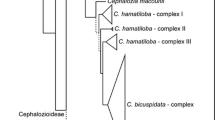Abstract
A molecular phylogeny of the Didiereaceae was produced through parsimony analysis of chloroplastrpl16 intron andtrnL-trnF andtrnT-trnL intergenic spacer sequences of all eleven species of the Didiereaceae and several outgroup taxa from the Portulacaceae. Results indicated that: 1) the Didiereaceae were embedded within the Portulacaceae, withCalyptrotheca as the sister group of the family; 2) present generic limits were supported; 3)Alluaudiopsis was the most basal lineage; 4) at least two separate episodes of polyploidization within the genusAlluaudia had occurred, and 5) unusually low amounts of variation were present in rapidly evolving noncoding plastid sequences.
Similar content being viewed by others
References
Behnke H.-D. (1969) Über Siebröhren-Plastiden und Plastidenfilamente der Caryophyllales. Untersuchungen zum Feinbau und zur Verbreitung eines weiteren spezifischen Plastidentyps. Planta 89: 275–283.
Behnke H.-D. (1976) Ultrastructure of sieve-element plastids in Caryophyllales (Centrospermae), evidence for the delimitation and classification of the order. Plant Syst. Evol. 126: 31–54.
Behnke H.-D. (1978) Elektronenoptische Untersuchungen am Phloem sukkulenter Centrospermen (incl. Didiereaceen). Bot. Jahrb. Syst. 99: 341–352.
Behnke H.-D., Mabry T. J., Eifert I. J., Pop L. (1975) P-type sieve element plastids and betalains in Portulacaceae (includingCeraria, Portulacaria, Talinella). Can. J. Bot. 53: 2103–2109.
Bremer K. (1988) The limits of amino acid sequence data in angiosperm phylogenetic reconstruction. Evolution 42: 795–803.
Donoghue M. J., Olmstead R. G., Smith F. J., Palmer J. D. (1992) Phylogenetic relationships of Dipsacales based onrbcL sequences. Ann. Missouri Bot. Gard. 79: 333–345.
Downie S. R., Palmer J. D. (1994) A chloroplast DNA phylogeny of the Caryophyllales based on structural and inverted repeat restriction site variation. Syst. Bot. 19: 236–252.
Downie S. R., Palmer J. D., Katz-Downie D. S., Cho K.-J. (1997) Relationships in the Caryophyllales as suggested by phylogenetic analyses of partial chloroplast DNAORF2280 homolog sequences. Amer. J. Bot. 84: 253–273.
Felsenstein J. (1985) Confidence limits on phylogenies: an approach using the bootstrap. Evolution 39: 783–791.
Hershkovitz M. A. (1993) Revised circumscriptions and subgeneric taxonomies ofCalandrinia andMontiopsis (Portulacaceae) with notes on phylogeny of the portulacaceous alliance. Ann. Missouri Bot. Gard. 80: 333–365.
Hershkovitz M. A., Zimmer E. A. (1997) On the evolutionary origins of the cacti. Taxon 46: 217–232.
Jensen U. (1965) Serologische Untersuchungen zur Frage der systematischen Einordnung der Didiereaceae. Bot. Jahrb. 84: 233–253.
Jordan W. C., Courtney M. W., Neigel J. E. (1996) Low levels of intraspecific genetic variation at a rapidly evolving chloroplast DNA locus in North American duckweeds (Lemnaceae). Amer. J. Bot. 83: 430–439.
Kelchner S. A., Clark L. G. (1997) Molecular evolution and phylogenetic utility of the chloroplastrpl16 intron inChusquea and the Bambusoideae (Poaceae). Mol. Phyl. Evol. 8: 385–397.
Kelchner S. A., Wendel J. F. (1996) Hairpins create minute inversions in non-coding regions of chloroplast DNA. Curr. Genet. 30: 259–262.
Kubitzki K. (1993) Didiereaceae. In: Kubitzki K., Rohwer J. G., Bittrich V. (eds.) The families and genera of flowering plants. Springer, Berlin, pp. 292–295.
Nyananyo B. L. (1986) The systematic position of the genusCalyptrotheca Gilg (Portulacaceae). Feddes Repert. 97: 767–769.
Nowicke J. W. (1975) Pollen morphology in the order Centrospermae. Grana 15: 51–77.
Rabesa Z. A. (1982a) Definition de deux sections du genreAlluaudia (Didiereaceae). Taxon 31: 736–737.
Rabesa Z. A. (1982b) Recherches chimiosystématiques sur les flavonoides des Didiéréacées. Trop. u. Subtr. Pflanz. 37: 339–358.
Rauh W., Dittmar K. (1970) Weitere Untersuchungen an Didiereaceen. 3. Teil. Vergleichend anatomische Untersuchungen an den Sprossachsen und den Dornen der Didiereaceen. Sitz. Heidelb. Akad. Wiss. 1969/70 (4): 163–246.
Rauh W., Reznik H. (1961) Zur Frage der systematischen Stellung der Didiereaceen. Bot. Jahrb. 81: 94–105.
Rauh W., Schölch H. F. (1965) Weitere Untersuchungen an Didiereaceen. 2. Teil. Inflorescenz-, blüetenmorphologische und embryologische Untersuchungen mit Ausblick auf die systematische Stellung der Didiereaceen. Sitz. Heidelb. Akad. Wiss. 1965(3): 221–434.
Raven P. H., Axelrod D. L. (1974) Angiosperm biogeography and past continental movements. Ann. Missouri Bot. Gard. 61: 539–673.
Rettig J. H., Wilson H. D., Manhart J. R. (1992) Phylogeny of the Caryophyllales — gene sequence data. Taxon 41: 201–209.
Rodman J. E., Oliver M. K., Nakamura R. R., McClammer J. U. Jr., Bledsoe A. H. (1984) A taxonomic analysis and revised classification of Centrospermae. Syst. Bot. 9: 297–323.
Rowley G. (1992) Didiereaceae: Cacti of the Old World. Kew: British Cactus and Succulent Society.
Rychlik W. (1992) OLIGO. Plymouth MN: National Biosciences Inc.
Schill R., Rauh W., Wieland H. P. (1974) Die Chromosomenzahlen der einzelnen Arten. Trop. u. Subtrop. Pflanz. 11: 1–14.
Straka H. (1975) Palynologie et différentiation systématique d'une famille endémique de Madagascar: les Didieréacées. Boissiera 24: 245–248.
Swofford D. L. (1993) PAUP: Phylogenetic analysis using parsimony, version 3.1.1. Washington, DC: Smithsonian Institution.
Swofford D. L. (1999) PAUP*: Phylogenetic analysis using parsimony (and other methods), version 4.0.0b2. Sunderland, MA: Sinauer Associates.
Taberlet P., Gielly L., Pautou G., Bouvet J. (1991) Universal primers for amplification of three noncoding regions of chloroplast DNA. Pl. Molec. Biol. 17: 1105–1109.
Thorne R. F. (1976) A phylogenetic classification of the angiosperms. Evol. Biol. 9: 35–106.
Thorne R. F. (1978) Plate tectonics and angiosperm distribution. Notes Roy. Bot. Gard. Edinburgh 36: 297–315.
Wallace R. S., Cota J. H. (1996) An intron loss in the choroplast generpoC1 supports a monophyletic origin for the subfamily Cactoideae of the Cactaceae. Curr. Genet. 29: 275–281.
Wu C.-I., Li W.-H. (1985) Evidence for higher rates of nucleotide substitution in rodents than in man. Proc. Natl. Acad. Sci. USA 82: 1741–1745.
Author information
Authors and Affiliations
Rights and permissions
About this article
Cite this article
Applequist, W.L., Wallace, R.S. Phylogeny of the Madagascan endemic family Didiereaceae. Pl Syst Evol 221, 157–166 (2000). https://doi.org/10.1007/BF01089291
Received:
Accepted:
Issue Date:
DOI: https://doi.org/10.1007/BF01089291




